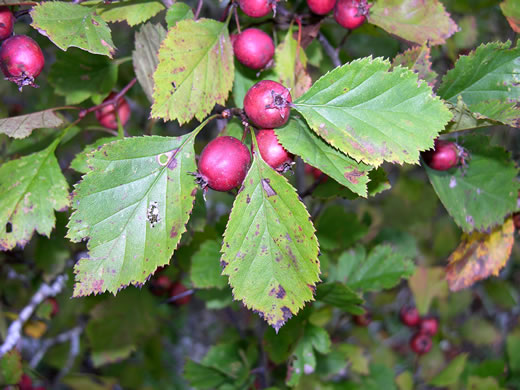Spermatophytes (seed plants): Angiosperms (flowering plants): Eudicots: Core Eudicots: Rosids: Fabids: Rosales
Series: Intricatae
WEAKLEY'S FLORA OF THE SOUTHEASTERN US (4/24/22):
Crataegus craytonii
FAMILY
Rosaceae
Go to FSUS key
Dig deeper at SERNEC, a consortium of southeastern herbaria.
Read more about Crayton Hawthorn at Vascular Plants of North Carolina.
A rare and sporadic species poorly understood due to a paucity of collections. Allied to C. intricata Lange but unique in its combination of 20- stamened flowers and copiously pubescent foliage and inflorescence, per Weakley's Flora (2022)
SYNONYMOUS WITH Flora of North America north of Mexico, vol. 9 (2014)
Crataegus craytonii
SYNONYMOUS WITH Haws: A Guide to Hawthorns of the Southeastern US (Lance, 2014)
Crataegus craytonii
SYNONYMOUS WITH Beadle in Flora of the Southeastern US (Small, 1913)
Crataegus craytonii
COMMON NAME:
Crayton Hawthorn
To see larger pictures, click or hover over the thumbnails.
Ron Lance rwlcintricata_vcraytonii
September AL
Leaves ovate, often slightly lobed, pubescent, 4-8cm, per Haws: A Guide to Hawthorns of the Southeastern US (Lance, 2014).
WEAKLEY'S FLORA OF THE SOUTHEASTERN US (4/24/22):
Crataegus craytonii
FAMILY
Rosaceae
SYNONYMOUS WITH
Flora of North America north of Mexico, vol. 9
Crataegus craytonii
SYNONYMOUS WITH
Haws: A Guide to Hawthorns of the Southeastern US (Lance, 2014)
Crataegus craytonii
SYNONYMOUS WITH
Beadle in Flora of the Southeastern US (Small, 1913)
Crataegus craytonii
If a search such as "Carex leptalea var. leptalea" doesn't deliver the results you want, try "Carex leptalea".
Or, to minimize chances of a misspelling, try just "Carex le".
Less is more: If "pencil flower" doesn't deliver the results you want, try "pencil".


